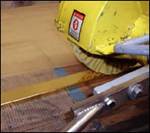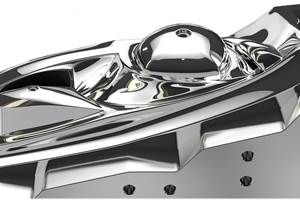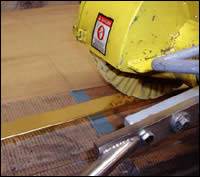Polishing Pointers-Saving Time On Ribs
Ask most shop owners what the number one reason is for new molds failing their first sample and you will most likely hear "material sticking in the ribs."
Ask most shop owners what the number one reason is for new molds failing their first sample and you will most likely hear "material sticking in the ribs." It is not uncommon for a tool to have its ribs and slots repolished two, three or more times before the tool works cleanly. The following is a list of different polishing techniques along with the pros and cons of each - and some tips and secrets to not only cut polishing time, but ensure a smooth-running tool every time.
The Problem
EDM is the primary reason material sticks in ribs. Not only can the surface be extremely rough, its hardness (the white coat) ranges about 72 Rockwell due to the combination of heat, oil and carbon - which are primary elements of heat treating steel. The combination of surface hardness and roughness leads to long hours of polishing, which despite the polisher's best efforts, may still result in a poor performing tool. Undercut ribs due to cutter flexing also is an issue, but this article will deal solely with EDM-related problems and its solutions.
Disking
The technique of disking ribs is probably the fastest way to remove EDM from ribs; however, the downside can easily outweigh the benefits. Disked ribs can become undercut extremely easily - in a matter of only a second - and this technique should only be used by an experienced polisher with many years of "feeling with his fingers" - or discarding the block and starting all over again is a real possibility. Young and inexperienced polishers - often intent with impressing the owner with their great speed and who are totally ignorant of the severe consequences possible - are the least qualified people to use this technique, but are often the first to do so. Ironically, the older, more experienced polishers - who are the most capable of handling this technique - are the least eager to use it because of well-founded concerns about damaging the block. They opt to use other slightly slower, but safer methods. Several methods of disking ribs include:
- Putting a two- or three-inch disk in a one-inch disk holder and reaching down into the rib.
- Tearing off the attached center mount from a disk and then backing up the disk with a homemade thin steel disk, while using a cut-off wheel arbor to hold it all together. This allows both increased depth and pressure to be applied to the disk at once.
- Cutting an extra-large diameter steel disk from a sheet of galvanized steel -as in duct-working material - and mounting this disk onto a quarter-inch screw, then adding sticky-back strips of abrasives all along the cutting surfaces. These strips are easily replaced when they become worn out and allow for the disking of extremely deep ribs.
If disking is your choice, please be careful to leave 10 percent of the EDM on all of the surfaces to guarantee no damage to draft angles or the thickness of the rib.
Diamond Files
Diamond files are the next fastest cutting tools available for removing EDM from ribs after disking. Diamond files can be used in profilers, heavy-duty air profilers and by hand. One advantage is that the diamond's hardness is ideal for cutting through EDM's outer surface. Unfortunately, the cost of diamond files can be prohibitive - especially on larger jobs, which may require dozens of such files. Unwary polishers also have destroyed these files carelessly by pushing down on them too hard. They think that pressure makes them cut faster when in reality they were simply breaking the diamond particles off of the file. By embedding the particles into the steel they were exceeding the limits of the braze that holds the diamond onto the file - resulting only in stripping the file clean and wasted time and money. The ultimate tool would be something that stays sharp forever and holds diamond without the particles breaking off.
Steel Laps
Steel laps are the tool of choice for most polishers. Steel can be ground to any thinness and still allow for heavy downward pressure. Steel laps can be used with diamond compound or silicon carbide lapping compound as the cutting medium. Lapping compound is only slightly slower than diamond, but considerably cheaper. Unfortunately, the downside to steel laps is greater than the benefits derived from them - steel laps often create deep, "zig-zag" lines in the side walls of the ribs, which are often far worse than the EDM with which they started. This is due to "scoring" between the steel rib wall and the steel lap. The only way to get around this uncontrolled scoring is to not push down so hard, but this also slows down the cutting process. Another big disadvantage to steel laps is the combination of downward pressure and the cutting action of the profiler, which often causes the diamond or lapping compound particle to simply shatter into fine grains. Shattering the rough grain and leaving a fine grain wastes time. The ultimate tool would allow downward pressure without shattering the larger size grains.
Two examples of steel laps are:
- Pre-hard rod cut to thickness and length.
- Stainless steel butter knives are often already the perfect thickness, blade length and strength for deep rib work and are the ideal width for mounting sticky-back, press-on paper abrasives. They also can be mounted into profilers and heavy-duty air profilers.
Brass Laps
Brass laps also are very popular for lapping ribs. While not quite as rigid as steel laps, brass laps are easier to work to thickness and shape and they don't suffer nearly as much from the deep, zigzag scoring as steel laps do. Overall, brass laps may be the most finish control-orientated lap being used. The downside is the large grains of diamond and lapping compound are still shattering from the pressure and cutting action of the profiler, which results in slower times to finish.
Copper Laps
Although copper laps are hardly ever used, they are extremely valuable to the polisher. Their use offers a great improvement in time saved while polishing ribs. This is due to the softness of the copper itself. Copper laps are so soft that the rough grain of diamond or lapping compound never breaks into fine particles. Instead, the large particles embed themselves into the soft copper and become a truly aggressive cutting tool - causing more wear to the EDM than any other form of lap. Unfortunately, copper is so soft that dressing it down thinly enough for most ribs takes all of the strength out of the lap itself - making it practically useless except for the widest and shallowest of ribs. Whenever possible, copper laps should be used as a great timesaver.
Stones
Nothing else cuts EDM faster and has a more controllable finish than a stone. While diamond files start off as being faster than stones, they quickly wear down from use and do not replenish their cutting action with new layers underneath as stones do. The fastest of all stones is a medium, hard-bond, aluminum oxide, nonoil-filled, 220-grit stone. This type of stone, when used properly, is EDM's worst nightmare. The secret to proper use is to cut it to thinness, dress it with 220-grit (mesh) natural diamond and stone by hand with a side-to-side sweeping motion - exactly like a windshield wiper on a car. This action will tear EDM out of a rib faster than any other method and allow the polisher to maintain total control over the final finish. The downside is that all stones break very easily when dressed down this thin. The cutting action is phenomenal, but when pressure is applied the stone always snaps off. The only thing this combination needs is the strength of steel or brass to become the ultimate rib polishing tool.
The Ultimate Rib Polishing Tool
Take a brass lap, dress it to half the thinness of the rib, take a 220-grit, medium, hard-bond, aluminum oxide, nonoil-filled stone and slice it to half the thinness of the rib. Then smooth off the tip of the brass lap, apply a drop of ethyl cyanoacrylate glue (instant nail glue available at any drug store) and glue the slice of stone directly to the lap. Wait about a minute, then apply just enough 220-grit natural diamond compound to impregnate the pores of the stone and start the sweeping action on the EDM - you are now using the ultimate rib polishing tool.
This combination offers the following benefits:
- It accelerates controlled EDM stock removal like no other motion or technique.
- The 220-grit diamond is not shattering at all because it's embedded safely in the pores of the stone.
- The diamond compound remains aggressive until it is completely worn out and then is easily refreshed by applying just enough compound so as to refill the pores in the stone.
- It also may be used as "draw" in a profiler, but side-to-side sweeping is much faster; therefore, draw should only be used to finish and not to rough out.
- The fact that the 220-grit diamond particles fall so neatly into the pores of the 220-grit stone creates nothing less than a "super" diamond file, which is glued to a brass lap that is unbreakable and will never wear out.
- When the stone slice wears out, simply glue another one back on and you have a brand-new, super diamond file.
- One five-gram tube of 220-grit (mesh) natural diamond applied properly is enough to easily polish all of the ribs most shops produce in six months or more.
Gluing a piece of stone onto a brass lap, charging it with natural diamond and using it in a sweeping side-to-side motion is nothing more than taking the best parts of several different techniques. This solution has worked very well over the years and has cut rib polishing time on some jobs by as much as 50 percent or more - without risking rib damage.
Related Content
What You Need to Know About Hot Runner Systems and How to Optimize Their Performance
How to make the most out of the hot runner design, function and performance.
Read MoreLaser Welding Versus Micro Welding
The latest battle in finely detailed restoration/repair of mold materials.
Read MoreHands-on Workshop Teaches Mold Maintenance Process
Intensive workshop teaches the process of mold maintenance to help put an end to the firefighting culture of many toolrooms.
Read MoreHow to Achieve the Best Mold Finish
A look at factors that impact the polishability of tool steels and recommendations for obtaining a high-gloss finish.
Read MoreRead Next
Conveying Luxury in Polished Metal
How one shop produces architectural pieces with jewel-like finishes
Read MoreReasons to Use Fiber Lasers for Mold Cleaning
Fiber lasers offer a simplicity, speed, control and portability, minimizing mold cleaning risks.
Read More



















.jpg;maxWidth=970;quality=90)